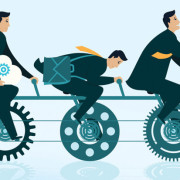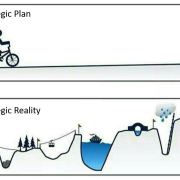The 7 shifts in thinking that successful organisations will be embracing in 2017
As the year starts to wind down, I like to immerse myself in the thinking that I believe should shape the coming year. My take on #BigIdea2017 is that more organisations will look to actively make their people the engine that drives not only the operational elements of the business, but also its growth, development and adaptation. In 2017, I believe we will see a fundamental move away from getting our people to engage in what the business values to valuing what our people have to offer the business.

Through my work in helping organisations to adapt and thrive in challenging new circumstances I’ve identified seven crucial shifts in thinking that will support ongoing success:
1. Recognising that people are no longer cogs in the organisational machine
We’ve come a long way since the turn of the 20th century when management theory pioneer Fredrick Taylor postulated that businesses were large complex machines and that employees were but cogs in that machinery. Get them all turning in the right direction and meshing effectively together and the machine will run smoothly.
The complexity of the business landscape has increased. Technology and even artificial intelligence are moving from the cutting edge to the foundation on which businesses are built. Even so-called blue collar industries are so imbued with complex equipment and bespoke installations that they are far from repetitious routine.
As a result, the vast majority of today’s workplaces require knowledge work – they rely on the skills, experience and THINKING of their people to drive business performance. The more that we tap into this thinking – this wellspring of skills, experience and knowledge – the better our businesses perform and the more they thrive as the environment changes.
Yet, all too seldom do organisations look to bring out the greatness in their people. Instead, we continue to see management approaches that focus on the flaws and shortcomings of employees.
But this is slowly changing and in the coming year we will see a push to actively engage and amplify what is “right” with our people.
2. Moving from top-down to outside-in
Much time, money and energy is expended on figuring out how to bring employees on the business’s journey – engaged and motivated to be part of a compelling business vision.
Jim Collins talks extensively in Good to Great about getting “the right people on the bus”. He then goes on to provide examples of how great leaders built their bus and the methods they used to ensure their employees were in the right seats on the bus – presumably as willing passengers.
In his excellent book, Drive: The Surprising Truth About What Motivates Us, Daniel H. Pink discusses what behavioural science tells us about the power of intrinsic motivation in generating engagement and fostering creativity in teams. He talks extensively about the characteristics of a highly engaged and motivated organisation. He goes on to provide examples and tips for organisations to make the leap to what he calls ‘Motivation 3.0’ – where completing the task is the reward.
These works start to expose a shift that has been happening in the world’s top-performing organisations for the last five years. A move from top-down to outside-in. Where change, improvement and new ways of doing business no longer come from the top of the organisation down to “the troops” but instead come from the operational edge of the business into its strategic core.
During 2017, businesses will stop seeing themselves as separate and apart from their people – hoping that they can entice or inspire them to share the business’s vision. They will recognise that the business is its people and that business performance is a symbiotic bond that cannot be broken into its component parts.
In my previous article I talked about how greatness, not leadership, was the most important quality for a thriving organisation. As organisations look for better ways to adapt and thrive in the ever-increasing pace of business change, they turn to their people to help shape this culture of greatness.
3. Viewing change as an opportunity for growth
The entire change management discipline is focused on managing people’s reaction and resistance to change. Yet one of the things that sets human beings apart is our ability to adapt to change and reshape the culture of a “tribe” to suit the prevailing needs of the group. It is not an inherent resistance to change that needs to be managed. It is the need for people to be a part of any change that affects them so they don’t feel fear, uncertainty or a loss of control.
The organisation of the future will be one that is built for and embraces change as an opportunity for growth. We will start to see a shift in the relationships that employees have in shaping that change. The most adaptable organisations will utilise the insights and experience of their teams to determine the specific changes required to improve performance outcomes as well as understanding where the next changes need to happen to keep up with shifting environment.
4. Becoming more intentional about engagement
Much focus in the human resources space has been placed on increasing engagement. A decade and a half of research shows that less than a third of employees are fully engaged at work. Much of this same research shows that there is a strong correlation between engagement and job satisfaction. As a result, the engagement push has been largely around creating more enjoyable workplaces to take advantage of this relationship.
As we move into 2017, we are going to see a shift to creating workplaces where employees have something to engage with. Where staff are brought together in teams and asked to solve the organisation’s most pressing problems based on their superior knowledge of the underlying cause of those problems.
5. Making accountability an agreement
Accountability is one of the most commonly used words in management circles, yet one of the least understood. What it actually means, both in technical definition and in practical application, is to accept responsibility, liability or be answerable. Often, we seek to attach accountability to results in the hope that it will motivate performance.
However, most meaningful results are not under the control of an individual – they come from the collective performance of a team.
As this collective team dynamic becomes a greater part of the way we manage performance, we will start to see a move toward making individuals accountable for their actions rather than results. This accountability will be centred on an “agreement” around actions – on people’s commitments – rather than through task assignments. In this way, the team will be collectively accountable for performance via the network of commitments that they make to each other.
Accountability will be less about who is to blame and more directly intertwined with shaping the performance culture. It will mean that for each person to serve the needs and meet the expectations of their fellow team members, they need to do what they say they will do. It is in meeting their need to serve the team that individuals will serve the organisation.
6. Understanding that leadership is a “support function”
In 2017, support will become the essential leadership quality that allows a business’s people to be the driving force behind its success. In his book, The New Rules of Management, Peter Cook talks about the four different types of support roles:
- Champions – those that advocate for and sing the praises of the project team
- Advisors – those that lend their experience and expertise through advice and mentorship
- Assistance – support that directly or indirectly assists the team in carrying out the project activities
- Buddies – peers, colleagues or friends that provide encouragement and a sounding board.
To fulfil any of these roles it is necessary for a leader to connect rather than direct. It is in connection that the organisation’s leaders understand the type of support that the team needs to function most effectively. It is through connection that leaders from within the team can influence performance outcomes.
7. Fostering an intrapreneurial spirit through freedom
Much has been made in 2016 of bringing an entrepreneurial ethic to the corporate world; the nimble, fail-fast mentality of the start-up to established businesses. The challenge of realising this utopian world of being big like you’re small and being established like you’re new is that large established organisations aren’t small or new. Most are structures that have been built on layers of measurement and control that seek to wrestle their people into compliance and, ultimately, performance.
This sort of environment doesn’t value expansive thinking and stifles creativity. It breeds mediocrity and keeps everyone on the certain path. A path that is certain until it runs out.
In 2017, a few companies are going to recognise that the secret to unlocking this adaptive, responsive world is not in making their businesses entrepreneurial, but in feeding the entrepreneurial spirit of their people. They will focus less on creating spaces that look like corporate entrepreneurs – with bean bags, slides and trendy cafes. Instead they will create safe working environments for the “intrapreneur” to thrive.
This will mean giving up some organisational control and showing your people that you trust them to drive the bus. These organisations will create a sense of freedom. The freedom to explore new ideas in a meaningful operational way. The freedom to self-determine the way they work. Most of all, they will be given the freedom to dare to be great – to risk failure for the opportunity of greatness.
A quote that has sat prominently in every workspace I have been in for the last 20 years captures this spirit of intrapreneurial daring perfectly. It’s what I call the impeccability of greatness:
“It is not the critic who counts. Not the man who points out how the strong man stumbled or where the doer of deeds could have done better. The credit belongs to the man who is actually in the arena, whose face is marred by dust and sweat and blood; who strives valiantly; who errs and comes up short again and again; who knows the great enthusiasms, the great devotions; who spends himself in a worthy cause. Who at the best, knows in the end the triumph of high achievement, and who, at the worst, at least falls while daring greatly, so that his place shall never be with those cold timid souls who know neither victory nor defeat.”
Theodore Roosevelt, 26th President of the United States of America
In 2017, business leaders will move away from trying to create an environment where they hope an engaged and motivated workforce flourishes. Instead, they will ask their employees to partner with them to shape an exceptionally engaging and motivating workplace. They will create teams and form tribes that become the driving force behind businesses that delight their customers and deliver outstanding results for their shareholders. The top businesses in 2017 will have a culture of greatness – where its people dare greatly and its leaders facilitate greatness in those around them.
Questions for consideration in 2017:
- How are your people driving greatness in your business?
- What problems could you solve or advances could you make if you tapped into the power of your people?
- Do you try to fix your people or see your people as the solution?
Thanks for your time, and I wish you and your family a healthy and happy holiday season. I look forward to connecting with you in 2017.








Leave a Reply
Want to join the discussion?Feel free to contribute!